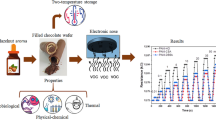Abstract
Unsaturated lipids exist in carton-board used for food packaging and can be the precursors of odorous compounds. The linoleic acid component may be in the form of a free acid, an alkyl ester derivative or a triglyceride. Oxidation proceeds via a free radical route to produce aldehydes, ketones, alcohols, furans, lower fatty acids, alkenes and alkanes, the majority of which are odorous. The aldehydes, in particular, have very low odour and taste detection thresholds, needing to be present only in very small amounts in a packaging material to cause a taint problem. Static headspace GC/MS analyses have identified a number of odorous compounds formed from the oxidation reactions. These oxidation reactions are affected to various extents by a number of factors that include temperature and the presence of photosensitising agents. Ultra-violet (UV) curable inks are commonly used in the printing of cellulosic carton-board packaging materials. These inks contain photoinitiators that have the potential to affect the rate and the extent of oxidation of unsaturated lipids, resulting in the formation of odorous compounds within the cellulosic carton-board matrix.
Similar content being viewed by others
References
Donetzhuber, A. (1982) Characterization of pulp and paper with respect to odour. The Ekman Dags, Stockholm, IV: 136, June 9-12, 1982.
Dravnieks, A. and Bock, F. C. (1978) Comparison of odors directly and through profiling. Chem. Senses and Flavour 2, 191-225.
Fengel, D. and Wegener, G. (1984) In Wood: Chemistry, Ultrastructure, Reactions. Ber: Walter de Gruyter & Co., pp. 182-226.
Fowler, G. J. S. and Devonshire, R. (1991) Photobleaching of 1,3-diphenylisobenzofuran by novel phthalocyanine dye derivatives. J. Photochem. Photobiol. 14 (1992), 177-185.
Grosch, W. (1987) Reactions of hydroperoxides-products of low molecular weight. In Autoxidation of Unsaturated Lipids. H. W. S. Chang (ed.). Academic Press, London, pp. 95-139.
Labuza, T. P. (1971) Kinetics of lipid oxidation in foods. CRC Critical Reviews in Food Technology 2, 355-405.
Meijboom, P. W. (1964) Relationship between molecular structure and flavor perceptibility of aliphatic aldehydes. J. AM. Oil Chem. Soc. 41, 326-328.
Pugh, S. (1998) Taint and Odour in Carton-board Packaging Systems. Ph.D. thesis, University of Leeds.
Söderhjelm, L. and Eskelinen, S. (1985) Characterization of packaging materials with respect to taint and odour. Appita. 38(3), 205-209.
Author information
Authors and Affiliations
Rights and permissions
About this article
Cite this article
Pugh, S., Guthrie, J. Development of taint and odour in cellulosic carton-board packaging systems. Cellulose 7, 247–262 (2000). https://doi.org/10.1023/A:1009222410875
Issue Date:
DOI: https://doi.org/10.1023/A:1009222410875




